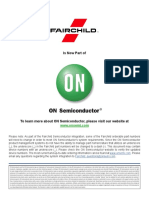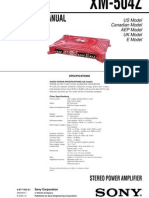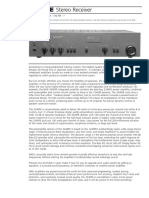Pam8403 PDF
Pam8403 PDF
Uploaded by
DEEPAK MAHTOCopyright:
Available Formats
Pam8403 PDF
Pam8403 PDF
Uploaded by
DEEPAK MAHTOOriginal Title
Copyright
Available Formats
Share this document
Did you find this document useful?
Is this content inappropriate?
Copyright:
Available Formats
Pam8403 PDF
Pam8403 PDF
Uploaded by
DEEPAK MAHTOCopyright:
Available Formats
A Product Line of
Diodes Incorporated
PAM8403
FILTERLESS 3W CLASS-D STEREO AUDIO AMPLIFIER
Description Pin Assignments
The PAM8403 is a 3W, class-D audio amplifier. It offers low THD+N,
allowing it to achieve high-quality sound reproduction. The new
filterless architecture allows the device to drive the speaker directly,
requiring no low-pass output filters, thus saving system cost and PCB
area.
With the same numbers of external components, the efficiency of the
PAM8403 is much better than that of Class-AB cousins. It can extend
the battery life, which makes it well-suited for portable applications.
The PAM8403 is available in SOP-16 package.
Features
3W Output at 10% THD with a 4Ω Load and 5V Power Supply
Filterless, Low Quiescent Current and Low EMI
Low THD+N
Superior Low Noise
Efficiency up to 90% Applications
Short Circuit Protection LCD Monitors / TV Projectors
Thermal Shutdown Notebook Computers
Few External Components to Save the Space and Cost Portable Speakers
Pb-Free Package Portable DVD Players, Game Machines
Cellular Phones/Speaker Phones
Typical Applications Circuit
PAM8403 1 of 11 November 2012
Document number: DSxxxxx Rev. 1 - 4 www.diodes.com © Diodes Incorporated
A Product Line of
Diodes Incorporated
PAM8403
Pin Descriptions
Pin Pin
Function
Number Name
1 +OUT_L Left Channel Positive Output
2 PGND Power GND
3 -OUT_L Left Channel Negative Output
4 PVDD Power VDD
5 MUTE Mute Control Input (active low)
6 VDD Analog VDD
7 INL Left Channel Input
8 VREF Internal analog reference, connect a bypass capacitor from VREF to GND.
9 NC No Connact
10 INR Right Channel Input
11 GND Analog GND
12 SHND Shutdown Control Input (active low)
13 PVDD Power VDD
14 -OUT_R Right Channel Negative Output
15 PGND Power GND
16 +OUT_R Right Channel Positive Output
Functional Block Diagram
PAM8403 2 of 11 November 2012
Document number: DSxxxxx Rev. 1 - 4 www.diodes.com © Diodes Incorporated
A Product Line of
Diodes Incorporated
PAM8403
Absolute Maximum Ratings (@TA = +25°C, unless otherwise specified.)
These are stress ratings only and functional operation is not implied. Exposure to absolute maximum ratings for prolonged time periods may
affect device reliability. All voltages are with respect to ground.
Parameter Rating Unit
Supply Voltage 6.0
V
Input Voltage -0.3 to VDD +0.3V
Operation Temperature Range -40 to +85
Maximum Junction Temperature 150
Operation Junction Temperature -40 to +125 °C
Storage Temperature -65 to +150
Soldering Temperature 300, 5 sec
Recommended Operating Conditions (@TA = +25°C, unless otherwise specified.)
Parameter Rating Unit
Supply Voltage Range 2.5 to 5.5 V
Operation Temperature Range -40 to +85 °C
Junction Temperature Range -40 to +125 °C
Thermal Information
Parameter Package Symbol Max Unit
Thermal Resistance (Junction to Ambient) SOP-16 θJA 110
°C/W
Thermal Resistance (Junction to Case) SOP-16 θJC 23
PAM8403 3 of 11 November 2012
Document number: DSxxxxx Rev. 1 - 4 www.diodes.com © Diodes Incorporated
A Product Line of
Diodes Incorporated
PAM8403
Electrical Characteristics (@TA = +25°C, VDD = 5V, Gain = 24dB, RL = 8Ω, unless otherwise specified.)
Symbol Parameter Test Conditions Min Typ Max Units
VDD Supply Voltage 2.5 5.5 V
VDD = 5.0V 3.2
THD+N = 10%, f = 1KHz, RL = 4Ω VDD = 3.6V 1.6 W
VDD = 3.2V 1.3
VDD = 5.0V 2.5
THD+N = 1%, f = 1KHz, RL = 4Ω VDD = 3.6V 1.3 W
VDD = 3.2V 0.85
PO Output Power
VDD = 5.0V 1.8
THD+N = 10%, f = 1KHz, RL = 8Ω VDD = 3.6V 0.9 W
VDD = 3.2V 0.6
VDD = 5.0V 1.4
THD+N = 1%, f = 1KHz, RL = 8Ω VDD = 3.6V 0.72 W
VDD = 3.2V 0.45
VDD = 5.0V, PO = 1W, RL = 8Ω 0.15
f = 1kHz %
Total Harmonic Distortion Plus VDD = 3.6V, PO = 0.1W, RL = 8Ω 0.11
THD+N
Noise VDD = 5.0V, PO = 0.5W, RL = 4Ω 0.15
f = 1kHz %
VDD = 3.6V, PO = 0.2W, RL = 4Ω 0.11
GV Closed Loop Gain VDD = 3V to 5V 24 dB
VDD = 5.0V, Inputs AC-Grounded f = 100Hz -59
PSRR Power Supply Ripple Rejection dB
with CIN = 0.47µF f = 1kHz -58
VDD = 5.0V, PO = 0.5W, RL = 8Ω,
CS Crosstalk f = 1kHz -95 dB
GV = 20db
SNR Signal-to-Noise Ratio VDD = 5.0V, VORMS = 1V, GV = 20db f = 1kHz 80 dB
VDD = 5.0V, Inputs AC-Grounded No A-Weighting 100
VN Output Noise µV
with CIN = 0.47µF A-Weighting 150
Dyn Dynamic Range VDD = 5.0V, THD = 1% f = 1kHz 90 dB
RL = 8Ω, THD = 10% 87
η Efficiency f = 1kHz %
RL = 4Ω, THD = 10% 83
VDD = 5.0V 16
IQ Quiescent Current VDD = 3.6V No Load 10 mA
VDD = 3.0V 8
IMUTE Muting Current VDD = 5.0V VMUTE = 0.3V 3.5 mA
ISD Shutdown Current VDD = 2.5V to 5.5V VSD = 0.3V <1 µA
Static Drain-to-Source PMOS 180
RDS(ON) IDS = 500mA, VGS = 5V mΩ
On-State Resistor NMOS 140
fSW Switching Frequency VDD = 3.0V to 5.0V 260 kHz
VOS Output Offset Voltage VIN = 0V, VDD = 5.0V 10 mV
VIH Enable Input High Voltage VDD = 5.0V 1.5 1.4
V
VIL Enable Input Low Voltage VDD = 5.0V 0.7 0.4
VIH MUTE Input High Voltage VDD = 5.0V 1.5 1.4
V
VIL MUTE Input Low Voltage VDD = 5.0V 0.7 0.4
OTP Over Temperature Protection 140 V
No Load, Junction Temperature VDD = 5.0V
OTH Over Temperature Hysterisis 30 V
PAM8403 4 of 11 November 2012
Document number: DSxxxxx Rev. 1 - 4 www.diodes.com © Diodes Incorporated
A Product Line of
Diodes Incorporated
PAM8403
Typical Performance Characteristics (@TA = +25°C, unless otherwise specified.)
PAM8403 5 of 11 November 2012
Document number: DSxxxxx Rev. 1 - 4 www.diodes.com © Diodes Incorporated
A Product Line of
Diodes Incorporated
PAM8403
Typical Performance Characteristics (cont.) (@TA = +25°C, unless otherwise specified.)
PAM8403 6 of 11 November 2012
Document number: DSxxxxx Rev. 1 - 4 www.diodes.com © Diodes Incorporated
A Product Line of
Diodes Incorporated
PAM8403
Application Information
Application Note
1. When the PAM8403 works with LC filters, it should be connected with the speaker before it's powered on, otherwise it will be damaged easily.
2. When the PAM8403 works without LC filters, it's better to add a ferrite chip bead at the outgoing line of speaker for suppressing the possible
electromagnetic interference.
3. The recommended operating voltage is 5.5V. When the PAM8403 is powered with four battery cells, it should be noted that the voltage of four
new dry or alkaline batteries is over 6.0V, higher than its operation voltage, which will probably damage the device. Therefore, it's
recommended to use either four Ni-MH (Nickel Metal Hydride) rechargeable batteries or 3 dry or alkaline batteries.
4. One should not make the input signal too large. Large signal can cause the clipping of output signal when increasing the volume. This will
damage the device because of big gain of the PAM8403.
5. When testing the PAM8403 without LC filters by using resistor instead of speaker as the output load, the test results, e.g. THD or efficiency,
will be worse than those of using speaker as load.
Test Setup for Performance Testing
Notes: 1. The AP AUX-0025 low pass filter is necessary for class-D amplifier measurement with AP analyzer.
2. Two 22μH inductors are used in series with load resistor to emulate the small speaker for efficiency measurement.
Maximum Gain
As shown in block diagram (Page 2), the PAM8403 has two internal amplifier stages. The first stage's gain is externally configurable, while the
second stage's is internally fixed. The closed-loop gain of the first stage is set by selecting the ratio of RF to RI while the second stage's gain is
fixed at 2x.The output of amplifier 1 serves as the input to amplifier 2, thus the two amplifiers produce signals identical in magnitude, but different
in phase by 180°. Consequently, the differential gain for the IC is
AVD = 20*log [2*(RF/RI)]
The PAM8403 sets maximum RF =142kΩ, minimum R =18kΩ, so the maximum closed-gain is 24dB.
Mute Operation
The MUTE pin is an input for controlling the output state of the PAM8403. A logic low on this pin disables the outputs, and a logic high on this pin
enables the outputs. This pin may be used as a quick disable or enable of the outputs without a volume fade. Quiescent current is listed in the
electrical characteristic table. The MUTE pin can be left floating due to the internal pull-up.
Shutdown Operation
In order to reduce power consumption while not in use, the PAM8403 contains shutdown circuitry to turn off the amplifier's bias circuitry. This
shutdown feature turns the amplifier off when logic low is applied to the SHDN pin. By switching the SHDN pin connected to GND, the PAM8403
supply current draw will be minimized in idle mode. The SHDN pin can be left floating due to the internal pull-up.
PAM8403 7 of 11 November 2012
Document number: DSxxxxx Rev. 1 - 4 www.diodes.com © Diodes Incorporated
A Product Line of
Diodes Incorporated
PAM8403
Application Information (cont.)
Power Supply Decoupling
The PAM8403 is a high performance CMOS audio amplifier that requires adequate power supply decoupling to ensure the output THD and
PSRR as low as possible. Power supply decoupling affects low frequency response. Optimum decoupling is achieved by using two capacitors of
different types targeting to different types of noise on the power supply leads. For higher frequency transients, spikes, or digital hash on the line,
a good low equivalent-seriesresistance (ESR) ceramic capacitor, typically 1.0μF, works best, placing it as close as possible to the device VDD
terminal. For filtering lower frequency noise signals, a large capacitor of 20μF (ceramic) or greater is recommended, placing it near the audio
power amplifier.
Input Capacitor (CI)
Large input capacitors are both expensive and space hungry for portable designs. Clearly, a certain sized capacitor is needed to couple in low
frequencies without severe attenuation. But in many cases the speakers used in portable systems, whether internal or external, have little ability
to reproduce signals below 100Hz to 150Hz. Thus, using a large input capacitor may not increase actual system performance. In this case, input
capacitor (CI) and input resistance (RI) of the amplifier form a high-pass filter with the corner frequency determined by equation below,
1
fC
2R I CI
In addition to system cost and size, click and pop performance is affected by the size of the input coupling capacitor, CI. A larger input coupling
capacitor requires more charge to reach its quiescent DC voltage (nominally 1/2 VDD). This charge comes from the internal circuit via the
feedback and is apt to create pops upon device enable. Thus, by minimizing the capacitor size based on necessary low frequency response,
turn-on pops can be minimized.
Analog Reference Bypass Capacitor (CBYP)
The Analog Reference Bypass Capacitor (CBYP) is the most critical capacitor and serves several important functions. During start-up or recovery
from shutdown mode, CBYP determines the rate at which the amplifier starts up. The second function is to reduce noise caused by the power
supply coupling into the output drive signal. This noise is from the internal analog reference to the amplifier, which appears as degraded PSRR
and THD+N.
A ceramic bypass capacitor (CBYP) with values of 0.47μF to 1.0μF is recommended for the best THD and noise performance. Increasing the
bypass capacitor reduces clicking and popping noise from power on/off and entering and leaving shutdown.
Under Voltage Lock-Out (UVLO)
The PAM8403 incorporates circuitry designed to detect low supply voltage. When the supply voltage drops to 2.0V or below, the PAM8403
outputs are disabled, and the device comes out of this state and starts to normal function when VDD ≥ 2.2V.
The PAM8403 has short circuit protection circuitry on the outputs to prevent damage to the device when output-to-output or output-to-GND short
occurs. When a short circuit is detected on the outputs, the outputs are disabled immediately. If the short was removed, the device activates
again.
Over Temperature Protection
Thermal protection on the PAM8403 prevents the device from damage when the internal die temperature exceeds +140°C. There is a 15 degree
tolerance on this trip point from device to device. Once the die temperature exceeds the thermal set point, the device outputs are disabled. This
is not a latched fault. The thermal fault is cleared once the temperature of the die is reduced by 30°C. This large hysteresis will prevent motor
boating sound well and the device begins normal operation at this point without external system intervention.
PAM8403 8 of 11 November 2012
Document number: DSxxxxx Rev. 1 - 4 www.diodes.com © Diodes Incorporated
A Product Line of
Diodes Incorporated
PAM8403
Application Information (cont.)
How to reduce EMI (Electro Magnetic Interference)
A simple solution is to put an additional capacitor 1000µF at power supply terminal for power line coupling if the traces from amplifier to speakers
are short (< 20cm).
Most applications require a ferrite bead filter as shown in Figure 2. The ferrite filter reduces EMI of around 1 MHz and higher. When selecting a
ferrite bead, choose one with high impedance at high frequencies, and low impedance at low frequencies.
Figure 2: Ferrite Bead Filter to Reduce EMI
Ordering Information
Part Number Part Marking Package Type Standard Package
PAM8403
PAM8403DR SOP-16 2500 Units/Tape&Reel
XATYWWLL
Marking Information
PAM8403 9 of 11 November 2012
Document number: DSxxxxx Rev. 1 - 4 www.diodes.com © Diodes Incorporated
A Product Line of
Diodes Incorporated
PAM8403
Package Outline Dimensions (All dimensions in mm.)
SOP-16
PAM8403 10 of 11 November 2012
Document number: DSxxxxx Rev. 1 - 4 www.diodes.com © Diodes Incorporated
A Product Line of
Diodes Incorporated
PAM8403
IMPORTANT NOTICE
DIODES INCORPORATED MAKES NO WARRANTY OF ANY KIND, EXPRESS OR IMPLIED, WITH REGARDS TO THIS DOCUMENT,
INCLUDING, BUT NOT LIMITED TO, THE IMPLIED WARRANTIES OF MERCHANTABILITY AND FITNESS FOR A PARTICULAR PURPOSE
(AND THEIR EQUIVALENTS UNDER THE LAWS OF ANY JURISDICTION).
Diodes Incorporated and its subsidiaries reserve the right to make modifications, enhancements, improvements, corrections or other changes
without further notice to this document and any product described herein. Diodes Incorporated does not assume any liability arising out of the
application or use of this document or any product described herein; neither does Diodes Incorporated convey any license under its patent or
trademark rights, nor the rights of others. Any Customer or user of this document or products described herein in such applications shall assume
all risks of such use and will agree to hold Diodes Incorporated and all the companies whose products are represented on Diodes Incorporated
website, harmless against all damages.
Diodes Incorporated does not warrant or accept any liability whatsoever in respect of any products purchased through unauthorized sales channel.
Should Customers purchase or use Diodes Incorporated products for any unintended or unauthorized application, Customers shall indemnify and
hold Diodes Incorporated and its representatives harmless against all claims, damages, expenses, and attorney fees arising out of, directly or
indirectly, any claim of personal injury or death associated with such unintended or unauthorized application.
Products described herein may be covered by one or more United States, international or foreign patents pending. Product names and markings
noted herein may also be covered by one or more United States, international or foreign trademarks.
This document is written in English but may be translated into multiple languages for reference. Only the English version of this document is the
final and determinative format released by Diodes Incorporated.
LIFE SUPPORT
Diodes Incorporated products are specifically not authorized for use as critical components in life support devices or systems without the express
written approval of the Chief Executive Officer of Diodes Incorporated. As used herein:
A. Life support devices or systems are devices or systems which:
1. are intended to implant into the body, or
2. support or sustain life and whose failure to perform when properly used in accordance with instructions for use provided in the
labeling can be reasonably expected to result in significant injury to the user.
B. A critical component is any component in a life support device or system whose failure to perform can be reasonably expected to cause the
failure of the life support device or to affect its safety or effectiveness.
Customers represent that they have all necessary expertise in the safety and regulatory ramifications of their life support devices or systems, and
acknowledge and agree that they are solely responsible for all legal, regulatory and safety-related requirements concerning their products and any
use of Diodes Incorporated products in such safety-critical, life support devices or systems, notwithstanding any devices- or systems-related
information or support that may be provided by Diodes Incorporated. Further, Customers must fully indemnify Diodes Incorporated and its
representatives against any damages arising out of the use of Diodes Incorporated products in such safety-critical, life support devices or systems.
Copyright © 2012, Diodes Incorporated
www.diodes.com
PAM8403 11 of 11 November 2012
Document number: DSxxxxx Rev. 1 - 4 www.diodes.com © Diodes Incorporated
You might also like
- PAM8302A: A Product Line of Diodes IncorporatedDocument14 pagesPAM8302A: A Product Line of Diodes IncorporatedAnonymous G1iPoNOKNo ratings yet
- A Product Line of Diodes Incorporated: Document Number: DSXXXXX Rev. 1 - 0Document11 pagesA Product Line of Diodes Incorporated: Document Number: DSXXXXX Rev. 1 - 0rdbm rdbmNo ratings yet
- PDF Diodes 882154Document8 pagesPDF Diodes 882154PablosoNo ratings yet
- ZVP4424ZDocument6 pagesZVP4424ZrecobauruNo ratings yet
- ZXLD1370Document39 pagesZXLD1370Iqbal Muzhaffar IsmailNo ratings yet
- PAM8006A: A Product Line of Diodes IncorporatedDocument13 pagesPAM8006A: A Product Line of Diodes IncorporatedSimilinga MnyongeNo ratings yet
- Voltage RegulatorDocument8 pagesVoltage RegulatorNANo ratings yet
- Pam8403 PDFDocument11 pagesPam8403 PDFShahzad RafiqNo ratings yet
- Features Gereral Description: Class AB Stereo Headphone DriverDocument10 pagesFeatures Gereral Description: Class AB Stereo Headphone DriverraveendraNo ratings yet
- Pam 8403Document11 pagesPam 8403skiziltoprakNo ratings yet
- NDT2955 1011659 PDFDocument7 pagesNDT2955 1011659 PDFRicardo FachinelloNo ratings yet
- Is Now Part ofDocument14 pagesIs Now Part ofSaadNo ratings yet
- DMN3350LDW DiodesDocument7 pagesDMN3350LDW DiodesJuan NunesNo ratings yet
- FDD6637 888878 PDFDocument11 pagesFDD6637 888878 PDFRED KaromiNo ratings yet
- Pam 2863Document11 pagesPam 2863Nguyen HoangNo ratings yet
- Is Now Part ofDocument8 pagesIs Now Part ofСергей БрегедаNo ratings yet
- FDT3612 D-2313126Document7 pagesFDT3612 D-2313126NalsonNo ratings yet
- PAM8406Document13 pagesPAM8406Bram PayNo ratings yet
- Is Now Part ofDocument9 pagesIs Now Part ofRene RuizNo ratings yet
- AIVR1004Document8 pagesAIVR1004SubhashChandraNo ratings yet
- FDD4243 46507Document9 pagesFDD4243 46507Tobias GadelhaNo ratings yet
- Data SheetDocument23 pagesData Sheetmarcos alvornozNo ratings yet
- FZT605 58355Document8 pagesFZT605 58355saikumarNo ratings yet
- Pam8610 PDFDocument15 pagesPam8610 PDFRaka Satria PradanaNo ratings yet
- Ds 30483Document6 pagesDs 30483Hisham MohamedNo ratings yet
- Ds 30483Document6 pagesDs 30483yoxan25808No ratings yet
- Is Now Part ofDocument8 pagesIs Now Part ofSamerNo ratings yet
- Is Now Part ofDocument11 pagesIs Now Part ofalexNo ratings yet
- DMP4015SK3: P-Channel Enhancement Mode MosfetDocument7 pagesDMP4015SK3: P-Channel Enhancement Mode MosfetpaulpuscasuNo ratings yet
- Is Now Part ofDocument6 pagesIs Now Part ofpeterfunNo ratings yet
- ON Semiconductor Is Now: To Learn More About Onsemi™, Please Visit Our Website atDocument6 pagesON Semiconductor Is Now: To Learn More About Onsemi™, Please Visit Our Website atpeternewsNo ratings yet
- Is Now Part ofDocument15 pagesIs Now Part ofSaikumarNo ratings yet
- RT7781GDocument23 pagesRT7781Gjuan pabloNo ratings yet
- PVD200 Proportional Valve Driver: Technical Data General Features PVD200Document3 pagesPVD200 Proportional Valve Driver: Technical Data General Features PVD200Sitt Nyein SoeNo ratings yet
- PAM8302A DatasheetDocument15 pagesPAM8302A DatasheetMarius NoybNo ratings yet
- APM8005K: Features Pin DescriptionDocument12 pagesAPM8005K: Features Pin DescriptionLeonardo Armando RomeroNo ratings yet
- FDD8880 DDocument12 pagesFDD8880 Dmartin.recmanNo ratings yet
- Zxmp4a16gq DiodesDocument7 pagesZxmp4a16gq DiodesashwinNo ratings yet
- TA2020-020 Stereo 20W (4 Using Digital Power Processing (DPP™) TechnologyDocument13 pagesTA2020-020 Stereo 20W (4 Using Digital Power Processing (DPP™) TechnologyReinaldo OrtizNo ratings yet
- Zetex: A Product Line of Diodes IncorporatedDocument9 pagesZetex: A Product Line of Diodes IncorporatedRik JacobNo ratings yet
- TLP7830 Datasheet en 20200625Document15 pagesTLP7830 Datasheet en 20200625home madeNo ratings yet
- HT760 Datasheet EN V1.0Document34 pagesHT760 Datasheet EN V1.0巩子辉No ratings yet
- Is Now Part ofDocument15 pagesIs Now Part ofu3a96e na1susNo ratings yet
- MT7842 MaxicTechnologyDocument6 pagesMT7842 MaxicTechnologyHeart of mountainNo ratings yet
- RT7736GGEDocument24 pagesRT7736GGEPedro AriasNo ratings yet
- Rohm Semiconductor Rohms16242 1 1742447Document6 pagesRohm Semiconductor Rohms16242 1 1742447himanshutripathi593No ratings yet
- Is Now Part ofDocument6 pagesIs Now Part ofJairo FernandezNo ratings yet
- 2n7002k DiodesDocument7 pages2n7002k DiodesRofo2015No ratings yet
- ONSemi NSI45090AZD DatasheetDocument6 pagesONSemi NSI45090AZD DatasheetLee Zhi-ChengNo ratings yet
- Lineardrive 210-d Spec-SheetDocument3 pagesLineardrive 210-d Spec-SheetomaNo ratings yet
- DMC3350LDWQ DiodesDocument10 pagesDMC3350LDWQ DiodesJuan NunesNo ratings yet
- Is Now Part ofDocument13 pagesIs Now Part ofPablo AllosiaNo ratings yet
- FDS6682 1008422Document8 pagesFDS6682 1008422ansifaNo ratings yet
- Irfr6215Pbf Irfu6215Pbf: V - 150V R 0.295 I - 13ADocument11 pagesIrfr6215Pbf Irfu6215Pbf: V - 150V R 0.295 I - 13AMiswantoNo ratings yet
- FDB2532 F085-888836Document14 pagesFDB2532 F085-888836Muhammad AwawdyNo ratings yet
- Is Now Part ofDocument9 pagesIs Now Part ofviyikitoNo ratings yet
- FQPF13N06L 1306265 PDFDocument11 pagesFQPF13N06L 1306265 PDFCristianNo ratings yet
- Analog Dialogue Volume 46, Number 1: Analog Dialogue, #5From EverandAnalog Dialogue Volume 46, Number 1: Analog Dialogue, #5Rating: 5 out of 5 stars5/5 (1)
- Radio Shack TRS-80 Expansion Interface: Operator's Manual: Catalog Numbers: 26-1140, 26-1141, 26-1142From EverandRadio Shack TRS-80 Expansion Interface: Operator's Manual: Catalog Numbers: 26-1140, 26-1141, 26-1142No ratings yet
- Analizador de EspectroDocument18 pagesAnalizador de EspectroPame CondoyNo ratings yet
- LA4525Document8 pagesLA4525Antonieta Cano CruzNo ratings yet
- Sony+XM 504Z+Car+Power+AmplifDocument18 pagesSony+XM 504Z+Car+Power+AmplifB.r. ArturoNo ratings yet
- Single Phase InverterDocument5 pagesSingle Phase InverterGajendra MuwelNo ratings yet
- A Technique For Improving Input Current Zero-Crossing Distortion of Boost PFC Converters For Airborne SystemDocument7 pagesA Technique For Improving Input Current Zero-Crossing Distortion of Boost PFC Converters For Airborne SystemInternational Journal of Research in Engineering and ScienceNo ratings yet
- Mitchell&Johnson Sap201vDocument22 pagesMitchell&Johnson Sap201vJean Luc LeroyNo ratings yet
- SG3K-D/SG4K-D/SG5K-D/SG6K-D: Residential String InverterDocument2 pagesSG3K-D/SG4K-D/SG5K-D/SG6K-D: Residential String InverterVictor SNo ratings yet
- Ultra Low Power Stereo Audio Codec With Embedded Minidsp: FeaturesDocument46 pagesUltra Low Power Stereo Audio Codec With Embedded Minidsp: FeaturesADHITYANo ratings yet
- USRP 2901-Based SISO-GFDM Transceiver Design Experiment in Virtual and Remote LaboratoryDocument16 pagesUSRP 2901-Based SISO-GFDM Transceiver Design Experiment in Virtual and Remote LaboratoryRendyHardiantoNo ratings yet
- 7KM PAC5100 5200 Measurin Devices Power Quality Flyers 7308 201701271126110970Document2 pages7KM PAC5100 5200 Measurin Devices Power Quality Flyers 7308 201701271126110970cc_bauNo ratings yet
- Arcam FMJ BrochureDocument23 pagesArcam FMJ BrochurePogodi TkoNo ratings yet
- SpectreRF Matlab ToolboxDocument20 pagesSpectreRF Matlab ToolboxluminedinburghNo ratings yet
- p40 Agile Brochure en 33136 202005 LTR r0011 LRDocument8 pagesp40 Agile Brochure en 33136 202005 LTR r0011 LRAndrawina NarasuraNo ratings yet
- Harmonics in Offshore Electrical Power SystemsDocument10 pagesHarmonics in Offshore Electrical Power SystemsP Venkata SureshNo ratings yet
- General Brochure (English) PDFDocument15 pagesGeneral Brochure (English) PDFAnnas Dwi SeptyadiNo ratings yet
- AMC1306x Small, High-Precision, Reinforced Isolated Delta-Sigma Modulators With High CMTIDocument44 pagesAMC1306x Small, High-Precision, Reinforced Isolated Delta-Sigma Modulators With High CMTICristian Elieser Avila RojasNo ratings yet
- Power Line Disturbance PDFDocument63 pagesPower Line Disturbance PDFs31314100% (1)
- NAD 3240PE Integrated AmplifierDocument2 pagesNAD 3240PE Integrated Amplifierpascalb41100% (1)
- Mos 100Document16 pagesMos 100lagmanr30No ratings yet
- Service Manual: Viewsonic N3251W-1 (M)Document122 pagesService Manual: Viewsonic N3251W-1 (M)Jim FordNo ratings yet
- Improvement of Power Quality Using PQ Theory Based Series Hybrid Active Power FilterDocument5 pagesImprovement of Power Quality Using PQ Theory Based Series Hybrid Active Power FilterijcctsNo ratings yet
- RXV 740Document152 pagesRXV 740tanie.miejsca.parkingoweNo ratings yet
- Tubes Vs TransistorsDocument18 pagesTubes Vs TransistorsamapandahukiNo ratings yet
- NSX-SZ50 - 2 PDFDocument36 pagesNSX-SZ50 - 2 PDFgnjida100% (1)
- PQM - CH 4 - 22042018 - 111440AM PDFDocument21 pagesPQM - CH 4 - 22042018 - 111440AM PDFYogesh KarlekarNo ratings yet
- Yamaha RX497 RecDocument46 pagesYamaha RX497 RecMaya TesNo ratings yet
- Fluke FLUKE 125B - NA DatasheetDocument11 pagesFluke FLUKE 125B - NA DatasheetCompras WConexNo ratings yet
- M300enbr EeDocument10 pagesM300enbr Eejaved shaikh chaand100% (1)
- SPWM Strategy For'an Open-End Winding Induction Motor Drive Using - Level Inverters With Separate SuppliesDocument4 pagesSPWM Strategy For'an Open-End Winding Induction Motor Drive Using - Level Inverters With Separate SuppliesGanesh ChallaNo ratings yet
- CTL-OP110 Ed 60 - 20140916Document11 pagesCTL-OP110 Ed 60 - 20140916AhmedSaadNo ratings yet

























































































